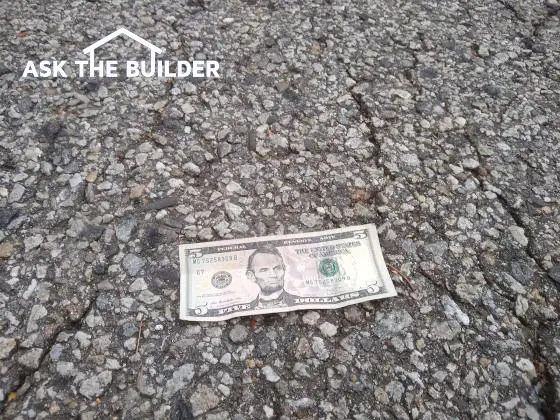Asphalt Sealer – Be Careful!

This is my asphalt driveway. See the early cracking. Asphalt sealers can seal these cracks preventing water infiltration. (C) Copyright 2019 Tim Carter
DEAR TIM: I had a new asphalt driveway installed back in the fall. It’s gorgeous and I want to keep it looking that way. I was told not to seal it until the spring. Is that correct? Is it possible to put on too much sealer? I don’t want to waste money so I’m looking for the solution that is the least amount of work over the long run if that makes sense. Does climate play a part in asphalt maintenance? Maggie M., Topeka, KS
Maggie’s got some great questions and you might have wondered about a few of them as well.
Asphalt driveways, some call them blacktop or hot top, are really a magnificent surface if they’re installed correctly. I’m hoping Maggie’s drive had at least 8 inches of compacted base stone that extends at least 6 inches wider than the actual asphalt paving on each edge of the drive. This extra stone ensures if a truck or car tire tracks on the edge of the drive, it won’t crack from lack of lateral support.
Asphalt driveways are much like concrete. The ingredients of both pavements are quite similar. Both contain rocks of different sizes and sand. Asphalt driveways then incorporate liquid asphalt cement to bind the rocks and sand together. Concrete relies on Portland cement that’s activated by the addition of water.
When the asphalt material is made, it’s tumbled in a giant mixer where the sand and rocks get heated, uniformly mixed, and completely coated with the proper amount of asphalt cement. Once the asphalt material is installed, compacted and cools, the lightweight oils in the asphalt cement need to evaporate.
This curing process takes a minimum of 90 days in ideal conditions where the temperatures are above 70 F or so in the daytime and don’t drop below 50 F at night. In colder climates, the curing might extend out six or even nine months. Don’t seal your new blacktop drive in its first year to ensure it’s fully cured.
In fact, you may not want to seal your new asphalt drive for several years. The reason new asphalt pavement is jet black is that the stones and sand are completely coated with the liquid asphalt cement. It can take several years before this coating wears off exposing pieces of stone. The pavement will then start to change color as you start to see the color of the stone matrix. This is your signal that it’s time to think about sealing the asphalt.
Climate plays a very big part with respect to the importance of sealing asphalt. I live in New Hampshire where the winters are brutal. Water that enters tiny cracks in asphalt paving freezes. Water expands as it freezes and this can start to widen cracks over time and pluck out individual stones in the asphalt paving. High-quality asphalt sealers can prevent this water damage if you monitor your asphalt making sure you seal the cracks.
The ultraviolet (UV) rays of the sun also pose a danger to all asphalt paving. A certain amount of UV light contains active photons. These energized particles act like miniature torpedoes and can blast apart the asphalt that’s holding the sand and stones together. Asphalt sealers can act as sacrificial coatings that prevent the UV rays from attacking the asphalt cement within the pavement.
You can put on too much sealer. It’s important to realize asphalt sealers are coatings. You need to put on a somewhat thin coating following the coverage instructions on the bucket. If you apply too much sealer too often before it wears out, it can start to peel and look horrible.
The best practice is to apply a great sealer and then let it wear off over a few years before you consider applying another coat. Once again, you’ll know when it’s time when you start to see lots of the stones with no coating on them and/or you start to see very tiny cracks that might be as wide as a piece of paper.
You may want that jet black look every year. I know a few people that do. If so, I urge you to buy the cheapest lowest-quality asphalt sealer you can find so that it wears off in nine months.
Climate does pay an important role in asphalt maintenance. Colder climates punish asphalt paving far more than warmer climates. Here in New Hampshire, we deal with wretched frost heaves that crack asphalt paving as if it were an egg being tapped on the side of a skillet.
Should you live in a cold climate it really pays each summer to clean your asphalt drive well. Check the entire driveway and inspect the pavement for tiny cracks. If you see them, then, by all means, begin a routine asphalt sealing program.
Column 1333
2 Responses to Asphalt Sealer – Be Careful!